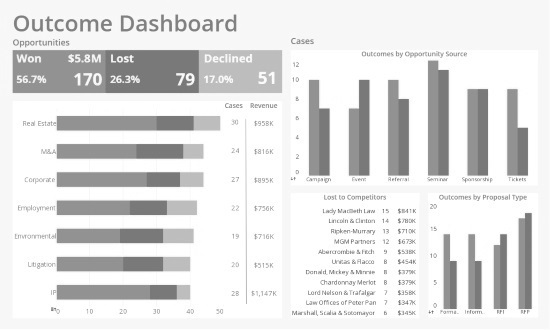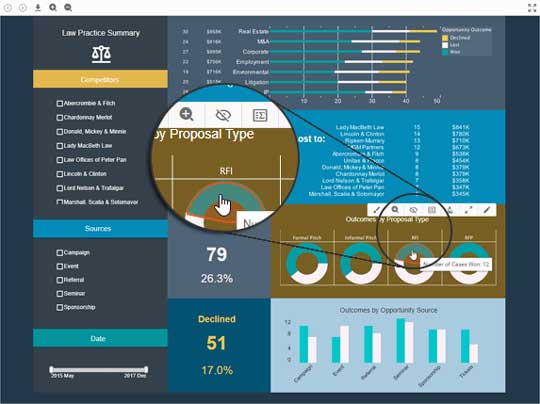Data Intelligence for Legal Firms
Could your law firm use an easy, flexible dashboard reporting system to track performance of its attorneys' productivity? Find the hidden trends, compare milestone performance, and identify top performers. Leading KPIs to track include number of matters opened, hours worked, number of average days billing in lockup, average fee per matter, and ratio of average billed to average worked rate
Legal Firm Dashboard Solution
Staying on top of KPIs can help identify issues ahead of time before they show up in the lagging key metrics such as fees billed in a month, hours billed, cash receipts, and revenue per lawyer. InetSoft's lightweight software for legal firms provides easy-to-use dashboard reporting design tools to create interactive monitoring and analytical dashboards that a non-technical partner can use to manage his or her team.
Client Analytics
Another key area for law firms to manage proactively is the performance of their existing client base. Key performance indicators in this area include client retention rate, which is the is the ratio of number of clients billed in the last 12 months to the same clients that had been billed in the 12 months before that. Another is the dormant client percentage rate, which is the ratio of the number of clients that the firm has not handled a matter for in two of the past three years to the number of total clients.
A related area to focus on is attorney productivity. Metrics include billable hours per full-time equivalent timekeeper, which is is calculated by taking the gross number of billable hours worked by paralegals, associates and partners and dividing by the number of full-time equivalents in each category. Another is the ratio of average billed to average standard rate, which is the ratio of the average billed hourly rate for a timekeeping category, which is calculated by dividing fees actually billed by the hours billed to the average standard hourly rate for the category of timekeeper.
Reasons Why Organizations Choose InetSoft


"Using Style Scope from InetSoft gave us the ability to provide a graphical representation of the key
data to top management right 'out-of-the-box' and move from static tables of numbers to charts and graphics
that are much easier to understand."
- Sergio R.
"I spent months looking for the best dashboard/reporting app to suit my business. I literally tried and tested every application out there and I have to say that the StyleBI App is by far the best. It is simple to use and it is absolutely brilliant if you are needing dashboards on custom objects." - Jacki A.
Other BI Applications in Law Practice Management
- Improve efficiency of e-discovery planning
- Improve data transparency to support decisions
- Compare a portfolio of cases and their relative productivity and cost
- Display a graphical view of real-time status on a document review project
- Synthesize data from disparate sources to answer questions about project status
- Anaylze the amount of time users spend on each matter can reveal staffing or training gaps

What KPIs Do Law Firms Track?
All organization, including law firms, must use key performance indicators (KPIs) to assess its performance. KPIs assist law firms in determining where improvements may be made, gauging the success of their operations, and making data-driven choices. We will talk about the KPIs that law firms use to measure their success and track their performance in this post.
Revenue
One of the most important KPIs for law companies is revenue. It is the whole sum of money a company makes by providing its services. To assess their overall financial health, expansion, and profitability, law firms evaluate their revenue. Billable and non-billable revenue are two further divisions of revenue.
Billable revenue is the cash the company receives in exchange for rendering services to customers, wherea s non-billable revenue refers to other sources of income, such as interest on the company's investments and accounts receivable.
Utilization Rate
Utilization rate is a KPI that gauges how much of an attorney's time is really spent on billable tasks as opposed to overall working hours. It aids legal companies in figuring out how productive their lawyers are and how well-equipped they are to manage more work. Although a low usage rate shows that the firm's lawyers may have capacity for further billable work, a high utilization rate indicates that the firm's attorneys are actively engaged in billable work.
Realization Rate
A KPI called realization rate counts the proportion of billable hours actually billed and paid for by customers. It assists law firms in evaluating the success of their billing procedure and identifying any areas for development. Although a low realization rate may indicate that the company is having difficulties with customer invoicing and money collection, a high realization rate shows that the firm's billing procedure is effective.
Collection Rate
The proportion of the firm's billed amounts that are actually paid by customers is measured by a KPI called collection rate. It helps legal firms in evaluating how well they manage their cash flow and collect payments. A high collection rate shows how effectively the company collects payments, whereas a low collection rate suggests that the company may be having trouble doing so.
Profit Margin
A KPI called profit margin assesses how profitable a legal practice is. It is the portion of income that is left over after all expenditures, like as overhead expenses, employee wages, and other operational costs, have been subtracted. A high profit margin shows that the business is running profitably and effectively, while a low profit margin may indicate that the business is struggling to turn a profit.
Client Satisfaction
Customer satisfaction is a KPI that gauges how happy clients are with the legal services they get. It supports legal firms in determining their areas of strength and helps them guarantee customer satisfaction. With surveys, feedback forms, and other methods of gathering customer input, law firms may gauge client satisfaction.
 |
Learn about the top 10 features of embedded business intelligence. |
Employee Satisfaction
Employee satisfaction is a KPI that gauges how happy people are with their employment and the working environment at a legal firm. It supports legal firms in identifying opportunities for development and ensuring staff engagement and motivation. With surveys, feedback forms, and other methods of gathering employee input, law firms may gauge employee happiness.
Time-to-Bill
A KPI called time-to-bill tracks how long it takes a legal company to charge customers for the services they received. It assists law firms in evaluating the effectiveness of their billing procedure and identifying any bottlenecks that could be causing a delay. Although a longer time-to-bill denotes that the company may be having difficulties with invoicing and payment collection, a shorter time-to-bill indicates that the firm's billing procedure is effective.
Matter Profitability
The profitability of certain cases the legal firm handles is measured by the KPI known as "matter profitability." It aids law firms in identifying the most lucrative matters and those that may need to be reassessed or restructured. By deducting a matter's direct expenses from its income, law firms may determine a matter's profitability.
New Business
A KPI called new business counts the number of new customers or cases that a legal firm has taken on within a certain time frame. It enables legal firms to evaluate the success of their business growth plans and pinpoint any areas that need improvement. Low new business means that the company may need to invest in new business development tactics, whereas a large quantity of new business shows that the company's business development plans are successful.
 |
Read the top 10 reasons for selecting InetSoft as your BI partner. |
Referral Rates
Referral rates are a KPI that tracks how many new customers or cases a law firm receives via recommendations from previous clients or other sources. It assists law firms in evaluating the success of their referral marketing initiatives and pinpointing any areas for development. Low referral rates imply that the company may need to invest in new reference marketing methods, while high referral rates show that the company's referral marketing strategies are successful.
Cost per Acquisition
A KPI called cost per acquisition tracks the expense of bringing on a new customer or topic. It enables legal firms to evaluate the success of their business growth plans and pinpoint any areas that need improvement. By dividing the overall cost of business development operations by the quantity of new customers or issues obtained, law firms may determine the cost per acquisition.
Client Retention Rate
A KPI called client retention rate tracks the proportion of customers who keep using a legal firm's services over time. It helps legal firms determine any areas for development and evaluate the success of their client retention strategy. When a company has a high client retention rate, it means that its client retention methods are working, but when it has a poor client retention rate, it may need to invest in new client retention techniques.
 |
Learn the advantages of InetSoft's small footprint BI platform. |
Diversity and Inclusion Metrics
KPIs for diversity and inclusion track how diverse and inclusive a law firm's staff and customers are. It aids law firms in evaluating their success in fostering a more diverse and inclusive workplace and pinpointing any areas that need improvement. The proportion of women, minorities, and LGBTQ+ people employed by the company, as well as the firm's efforts to promote diversity and inclusion in its employment and client relations procedures, are examples of diversity and inclusion metrics.
Pro Bono Hours
Pro bono hours are a KPI that tracks how many hours a law firm's lawyers donate to charitable causes. It aids law firms in evaluating their dedication to provide legal services to individuals who cannot pay them and identifying any areas that need improvement. A high percentage of pro bono hours shows a company's dedication to pro bono work, while a low percentage may indicate a need for the firm to devote additional resources to pro bono work.


